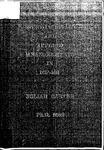FUNDAMENTAL AND APPLIED MEASUREMENTS IN ICP-MS
| dc.contributor.supervisor | E. Hywel Evans | |
| dc.contributor.author | CARTER, JULIAN ROBERT | |
| dc.contributor.other | Faculty of Science and Engineering | en_US |
| dc.date.accessioned | 2012-08-02T11:12:29Z | |
| dc.date.available | 2012-08-02T11:12:29Z | |
| dc.date.issued | 2002 | |
| dc.identifier | Not available | en_US |
| dc.identifier.uri | http://hdl.handle.net/10026.1/1085 | |
| dc.description.abstract |
Fundamental and applied aspects of ICP-MS have been investigated to gain an increased understanding of the technique and improve on its analytical capabilities. Dissociation temperatures of polyatomic ions were calculated using a double-focusing sector instrument, to obtain more reliable mass spectral data with controlled vapour introduction via a Dreschel bottle to allow accurate calculation of the ingredients in the plasma. The equilibrium temperature for the plasma, operated at 1280 W calculated using CO*, and as the thermometric probes, was c.a. 5800 - 7400 K, while using ArO* and ArC* as the thermometric probes the temperature calculated was c.a 2000 - 7000 K. Calculated dissociation temperatures were used to elucidate the site of formation of these ions. Results confirmed that strongly bound ions such as CO* and C2* were formed in the plasma whereas weakly bound ions such as ArO* and ArC* were formed in the interface region due to gross deviation of the calculated temperatures from those expected for a system in thermal equilibrium. The use of helium gas in a hexapole collision cell Attenuated the signals of ArH* Ar* ArO*, Arc*, ArCl* and Ara* allowing improved determination of ^^K*, *'Ca*, ^^e* ^^Cr*, ''As* and ^°Se*in standard solutions. The use of the hexapole collision cell also resulted in an enhancement of analyte signals due to the thermalisation of the ion beam. The ion kinetic energy of ions sampled from the plasma and those sampled from the skimmer cone were determined using a modified lens stack to assess the significance for memory effects of material deposited on the skimmer cone. The most probable kinetic energy of Be* ions sampled from the skimmer cone was found to be 2A eV, which was considerably lower than the most probable kinetic energy of Be* ions sampled from the plasma, which was found to be 9.5 eV. The low kinetic energy of the ions deposited on the skimmer cone means they will only contribute to the analytical signal under certain instrumental operating conditions. The feasibility of liquid sample introduction into a LP-ICP-MS system designed for gaseous sample introduction was investigated using a particle beam separator. The low signal was attributed to the low gas kinetic temperature of the plasma which was confirmed by the fact that the signal increased rapidly with increasing temperature of the transfer line between the particle beam separator and the LP-ICP torch. This was also supported by the fact that more volatile compounds gave mass spectra whereas less volatile compounds did not. A limit of detection of 30 mg 1'^ for chlorobenzene was achieved. Finally, silicon and phosphorus speciation was performed by HPLC coupled to sectorfield ICP-MS. Silicones ranging in molecular weight from 162 g mol'^ - 16500 g mol"^ were extracted from spiked human plasma and separated by size exclusion chromatography. Limits of detection ranged from 12 ng ml"' Si* for the 162 gmol'^ silicone to 30 ng ml'' Si* for the 16500 g mol' silicone. Organophosphate pesticides were extracted from spiked plasma and separated by reversed phase chromatography. Recoveries were between 55 - 81 %. Limits of detection were 0.9 ng ml'' P* 1.8 ng ml'' P* 1.6 ng ml"' P* and 3.0 ng ml'' P* for dichlorvos, methyl parathion, malathion and quinolphos respectively. Phosphates were extracted from various food products and separated by ion-exchange chromatography. Limits of detection were 1.0 ng ml"' P* 2.3 ng ml"' P*, and 39 ng ml"' P* for P04^", PaOy"^ and PsOio^" respectively. | en_US |
| dc.description.sponsorship | Department of Environmental Sciences; Ion path Road, Cheshire | en_US |
| dc.language.iso | en | en_US |
| dc.publisher | University of Plymouth | en_US |
| dc.title | FUNDAMENTAL AND APPLIED MEASUREMENTS IN ICP-MS | en_US |
| dc.type | Thesis | |
| dc.identifier.doi | http://dx.doi.org/10.24382/4460 |
Files in this item
This item appears in the following Collection(s)
-
01 Research Theses Main Collection
Research Theses Main


